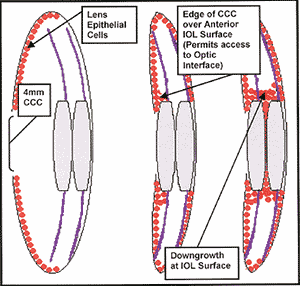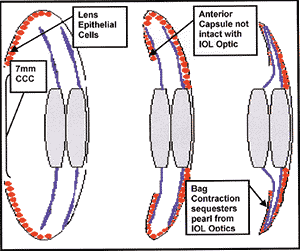Red rock syndrome: interlenticular opacification with piggyback lens implantation
This condition is associated with loss of best-corrected visual acuity.
 ---Stage 1 red rock syndrome: Scattered peripheral pearls.
---Stage 1 red rock syndrome: Scattered peripheral pearls.
Red rock syndrome (RRS) or interlenticular opacification (ILO) is a condition involving the development of Elschnig pearls at the lens interface with piggyback lens implantation. It has a late onset of 6 months to 2 years postoperatively and is associated with a loss of best-corrected visual acuity (BCVA) and a frequent hyperopic shift.
The condition has been classified into four clinical stages. Stage 1 illustrates scattered Elschnig pearls in the periphery of the interface. Stage 2 reveals expansion of the epithelial cells more centrally between the two optics, with occasional dendrite-like extensions radially. Stage 3 involves more peripheral expansion of the lens epithelial cells with an accompanying central fibrotic plaque in the area of the lens-optic contact. Stage 4 demonstrates complete opacification of the lens interface with significant loss of BCVA, hyperopic shift and loss of pseudoaccommodation.
Etiology
 ---Stage 3 red rock syndrome: Dense central plaque and extensions.
---Stage 3 red rock syndrome: Dense central plaque and extensions.
The etiology of this condition has been primarily attributed to the formation of a small capsulorrhexis. The lack of peripheral space between both optics initiates proliferation of lens epithelial cells. Furthermore, cell migration into the interface encourages the process of metaplasia into fibrocytes deep between the lenses to result in the dense, semi-opaque central plaques observed.
The hyperopic shift can be explained by a thickening of the anterior capsule. This causes a posterior shift of the two lenses, increases the area of central contact between the IOLs and also makes the peripheral lens bend. The combined resulting effect of these forces is a progressive hyperopic shift.
Surgical intervention for this condition is recommended prior to the development of stage 4, before strong adhesion develops between the lens optics.
Treatment
 ---Stage 4 red rock syndrome: Complete opacification of interface.
---Stage 4 red rock syndrome: Complete opacification of interface.
The most effective treatment of red rock syndrome thus far appears to involve the application of preoperative YAG laser to the radial quadrants of the anterior capsule. The “elastic band” of the thickened anterior capsule is released, and the lenses are free to relocate anteriorly, with a resultant decrease in optic contact. This technique reverses the effect of the hyperopic shift in varying degrees depending upon the amount and efficacy of the laser shots.
Surgical treatment should involve removal of the anterior lens from the capsular bag and insertion of a larger optic IOL in the sulcus. This approach, in theory, should prevent further epithelial cell growth with no contact between the two lenses.
The first step should be to enlarge the capsulorrhexis, which should not be as difficult with the preoperative YAG laser relaxing incisions. Bimanual separation of the two IOLs should be performed using two hooks and viscoelastic. Use of Sinskey or Kuglen hooks and a cannula can mechanically separate both optics. The anterior IOL can be transected with Chu scissors and removed from the eye. Irrigation and aspiration of the Elschnig pearls is then performed, and the central fibrotic plaque is polished. A new, larger optic IOL, such as the Alcon MA50BM (Alcon; Fort Worth, Texas) with an optic of 6.5 mm and length of 13.0 mm can then be inserted into the sulcus.
To prevent the onset of red rock syndrome, it may be advisable to routinely place one of the IOLs in the sulcus and the other in the capsular bag. Another option is to ensure that a larger capsulorrhexis is used to discourage cell growth. In the future, there is the need to investigate the use of pharmaceutical agents, lens materials and the possible use of capsular tension rings as another alternative to assist with the procedure of piggyback lens implantation in patients with severe hyperopia.
|
|
|
For Your Information:References:
- Ron Stasiuk, MB, BS, FRACO, FRACS, FAAO, can be reached at Blackburn South Eye Clinic, 156 Canterbury Road, Blackburn South VIC 3130, Australia; 61-3-9877-6288; fax: 61-3-9894-2691; e-mail: rstasiuk@medeserv.com.au.
- Findl O, Menapace R, Rainer G, et al. Contact zone of piggyback acrylic intraocular lenses. J Cataract Refract Surg. 1999;25:860-862.
- Gayton JL, Sanders VN. Implanting two posterior chamber intraocular lenses in a case of microphthalmos. J Cataract Refract Surg. 1993;19:776-777.
- Holladay JT, Gills JP, Leidlin J, et al. Achieving emmetropia in extremely short eyes with two piggyback posterior chamber intraocular lenses. Ophthalmology. 1996;103:1118-1123.
- Masket S. Piggyback intraocular lens implantation. J Cataract Refract Surg. 1998;24:569-570.
- Shugar JK, Schwartz MD. Interpseudophakos Elschnig pearls associated with late hyperopic shift: A complication of posterior chamber intraocular lens implantation. J Cataract Refract Surg. 1999;25:863-867.



